31 Days, 31 Lists: 2023 Fairy Tales, Folk Tales, and Religious Tales

Ah! One of my favorite categories! It’s so interesting to note the years where we get a SLEW of great fairy tales, folk tales, and religious tales versus the years when we get hardly any at all. 2023? Now that has been a good year! Why, when we were trying to pare down this category for the EPL 101 Great Books for Kids List, we found it to be particularly painful. Who knew there would be so many great titles coming out? In the old days, this was a boffo category, dominating even the picture books. And prior to this year I would have said that these days publishers just didn’t care about these categories anymore. Happily, they’ve proven me to be a liar. Check out these true beauties.
If you’d like a PDF of this year’s list, you can find it here.
And are you interested in seeing past lists of these titles? Then check these out!
2023 Fairy Tales, Folk Tales, and Religious Tales
All By Myself by Stephanie Shaw, ill. Emilie Gill
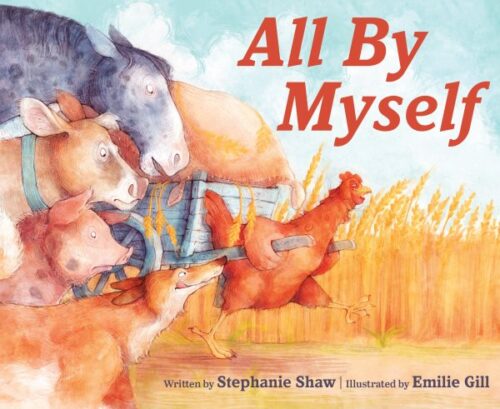
Dang it. This falls squarely into the Books Betsy Can’t Read the Titles of Without Wanting to Sing. “All by myself … don’t wanna be, all by mysee-ee-eelf!” So this is a book that sort of assumes that kids are familiar with the tale of the Little Red Hen. If you plan on reading this with them, make sure you read something like Heather Forest’s The Little Red Hen: An Old Fable beforehand. That way they’ll be able to fully appreciate the way this story twists the old one. In the classic telling of The Little Red Hen, the heroine asks for help and is denied it continually. In this story, the hen is perfectly happy doing all the work herself, in spite of offers of help. I can relate. I’m terrible at delegation myself. When a hungry fox comes to aid in the cooking process, her friends are fairly certain that she’s next on his menu. There’s a twist at the end, which reminded me a bit of My Lucky Day by Keiko Kasza but . . . not? Emilie Gill, is new to me but she is an excellent new artist and one that you need to add to your roster of folks to keep an eye on.
ADVERTISEMENT
ADVERTISEMENT
The Amazing and True Story of Tooth Mouse Pérez by Ana Cristina Herreros, ill. Violeta Lópiz, translated by Sara Lissa Paulson
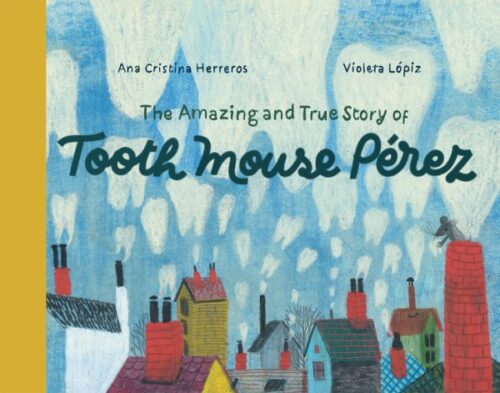
Losing teeth is “the gift of growing up”. See how the Spanish Tooth Mouse tradition has changed over the years and how it connects to our very own Tooth Fairy. Oh, I just love this! I’ve heard of teeth mice before and I’ve even seen books about different losing-your-teeth traditions from around the world (anyone remember I Lost My Tooth In Africa by Penda Diakite?). Still I’ve never seen a really really really good book on the subject before. Now, at long last, I think I have. This covers traditional tooth mouse folktales, sure, but it also acknowledges how times change and how people, and traditions, have to adapt. If you don’t live in houses with roofs then throw your tooth in the fireplace. There aren’t fireplaces now? Then put the teeth under your pillow! And then to weave in other tooth fairy/insect ideas as well? Fantastico. A thorough winner from start to finish. Previously Seen On: The Translation list
Ancient Night by David Álvarez and David Bowles
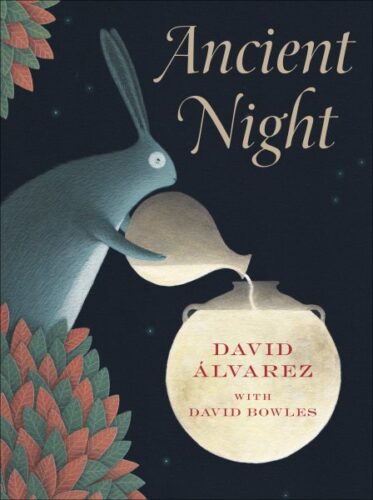
Every night Rabbit fills the moon with delicious aguamiel. When clever but foolish Opossum steals the liquid for himself, the two must work together to make things right. A smart mixture of multiple Mesoamerican legends. Now here’s a pretty one. I love a book that not only has the feel of a folktale but honors the roots of the tales themselves. Apparently this story has elements from such stories as the Mesoamerican “The Great Ceiba” and “Rabbit and the Moon” as well as “Opossum and the Sun’s Fire” and “Magey Aguamiel.” Love the tone, the storytelling, and (naturally) the feel of the art itself. A pretty clear-cut winner.
Big Bad Wolf’s Yom Kippur by David Sherrin, ill. Martín Morón

In the pantheon of great Yom Kippur picture books, few feature wolves in sleeveless plaid. Quite frankly, I think that’s a shame. Now as I was traversing the halls of the Annual American Library Association Conference this past June I made a point to sniff out all the smaller publishers of children’s books to see what goodies they might have to display. And Apples & Honey Press did not disappoint. I actually spotted this cover across a distance of at least ten feet and was instantly drawn in. And for good reason too! The story focuses on a Big Bad Wolf, not too dissimilar from the one you’ve seen in the book series/movie Bad Guys. The book centers on a Big Bad who follows the Jewish tradition of t’shuvah, returning to his best self on Yom Kippur. And while I thoroughly enjoyed the storyline and the art (which is top notch!) I really enjoyed the fact that having given up free meals throughout the book, the wolf gets to feast and feast at the story’s end. Probably, and I mean this truly, the best Yom Kippur picture book I’ve ever seen. Previously Seen On: The Holiday List
The Cat, the Owl, and the Fresh Fish by Nadine Robert, ill. Sang Miao, translated by Nick Frost and Catherine Ostiguy
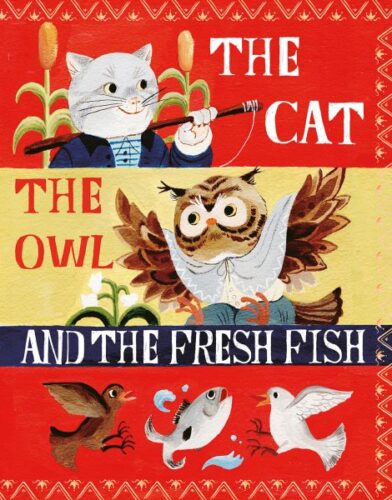
I’m sort of old-fashioned when it comes to folk and fairy tales. Generally speaking I try to avoid including any original ones on these lists. I don’t mind fractured tales, of course. Or tales that add some more contemporary elements. But wholly new? Not usually my style. Yet here we are, with me taking a gander at this little French-Canadian import and just absolutely adoring it! The story has all the hallmarks of an Aesop fable. In it, you’ve an owl who is trapped by a log on his foot. A nearby cat refuses to help because it has spotted a basket of fish in an abandoned boat in the middle of the pond. The owl keeps surreptitiously giving the cat advice on how to get closer until it manages to accidentally/not accidentally get the cat to pick up the log on its foot. The art of Sang Miao, meanwhile, has all the hallmarks of a classic picture book from 70 years ago. I walked in uncertain (the cursive letters threw me off at first) and then was utterly charmed. A delight. Previously Seen On: The Translation List
Counting on Naamah by Erica Lyons, ill. Mary Reaves Uhles

Ah! Another book for the Why Hasn’t Someone Thought of This Before category! To start of with, why hasn’t anyone turned the Noah’s Ark story into a math picture book before? Of all the tales in the Jewish or Christian religions, this one seems the most math friendly (though if Lyons and Uhles want to make a sequel, the loaves and fishes story might be a possibility). Best of all, Lyons gives the role of mathematician to Naamah, Noah’s wife. All kinds of different types of math are worked into the storyline, and the construction of the ark itself manages to teach and not bore. My sole objection? Well, aside from the fact that Naamah’s kids and their spouses somehow disappeared in the course of all this, there is the inescapable fact that this book would have been ripe for wonderful backmatter, and yet all we get are teeny tiny boxes on what a midrash is and who Naamah was. Such a lost opportunity! Lyons could have filled two additional pages with wonderful explanations of some of Naamah’s math, and even included little activities for kids to do. Ah well. As it stands, it’s a pretty darn good combination of classic tale and mathical mathiness. Previously Seen On: The Math Books for Kids List
Dream Big, Laugh Often and More Great Advice from the Bible by Hanoch Piven and Shira Hecht-Koller

Hanoch Piven’s back! That’s so great! I love that guy. He’s actually been around for quite a while, constructing these cheeky illustrations loaded down with personality in all kinds of picture books. This particular title would do very well indeed as a kind of Sunday school/Saturday school supplement to basic Old Testament studies. You’ve a range of famous figures paired alongside some advice. Some of these make sense (Noah’s advice centers “Be Good” and Abraham’s is “Trust the Journey”) while others take a bit of creative wrangling (I was a bit amused to see that Eve’s is “Be Curious”). What’s so neat is that often the bits and pieces that make up the person pertain to the lesson/person’s story in some fashion. So Jonah is made up of nautical elements like a flipper body and seashell eyes, for example. Definitely intended for those kids who already know these characters, this could still be used as a way of making them curious about the full stories (some of which are included in the back of the book). Sparking curiosity with advice!
Eagle Drums by Nasuġraq Rainey Hopson
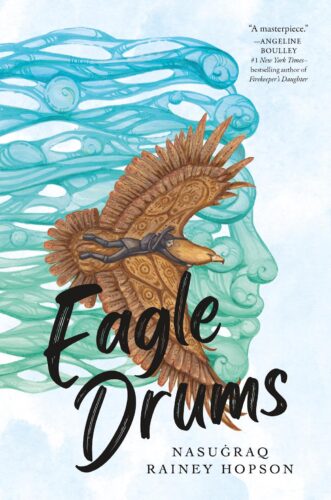

When Piŋa is confronted by a giant golden eagle, he’s given a choice: Join the eagle or suffer the same fate as his dead brothers. A marvelous retelling of the Inuit story of the origins of the Messenger Feast. I cannot stress enough how much I recommend that folks read this story. I had the luck to read it on vacation in the car, and I’m so glad that I did. It’s an Inuit folktale about the origins of the Messenger Feast, but Hopson (tribally enrolled Inupiaq born in Barrow Alaska now known as Utqiagvik, and raised in Point Hope Alaska) has gone above and beyond in terms of pulling together a truly harrowing tale from the barest bones of a story. I absolutely love this adaptation and feel that it belongs on this segment of the list, absolutely. Wonderful pacing, evocative, and by god if you’re not hungry for seal fat by the end of this, I’ll be surprised.
Eve and Adam and Their Very First Day by Leslie Kimmelman, ill. Irina Avgustinovich
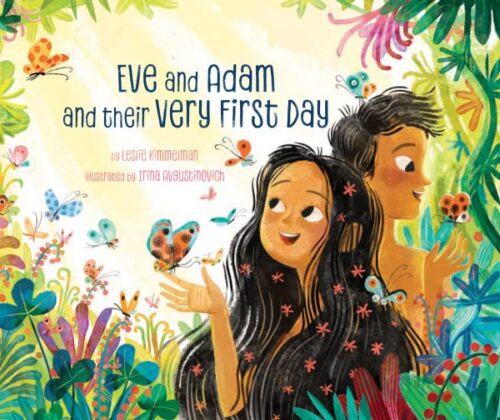
You know how sometimes a Biblical tale will be put it fairly non-religious terms when placed into a picture book? Noah’s Ark, for example, is sometimes completely distanced from anything but maybe the barest mention of God (see our previous entry, Counting on Naamah). Not so Adam and Eve. It’s a little hard to get away from the source material when you’re practically the first story in Genesis. Even so, I wasn’t certain what to expect with this picture book adaptation. I’d seen the lovely cover and read the premise, and (even better) I knew that author Leslie Kimmelman was an author I could trust. Still and all, you may have noticed that there aren’t a lot of Adam and Eve picture books on your public library shelves. Heck, one of the few times that Eric Carle has ever been banned was because of an Adam and Eve image in Draw Me a Star. Avgustinovich goes the Dirty Cowboy route with the nudity here, which is to say there are a lot of strategically placed leaves and fronds going on. Eve and Adam are also pretty darn childlike in their wide-eyed wonder. Interestingly (at least to me) the lesson of the book is that when there are unknowable things in the world, that doesn’t necessarily mean that those things are bad, and one should put one’s faith in God’s plan. Avgustinovich’s art makes this a cut above. This is one religious book that’s just gonna lean into being religious, and does so in a rather nice way.
Ganesha’s Great Race by Sanjay Patel and Emily Haynes
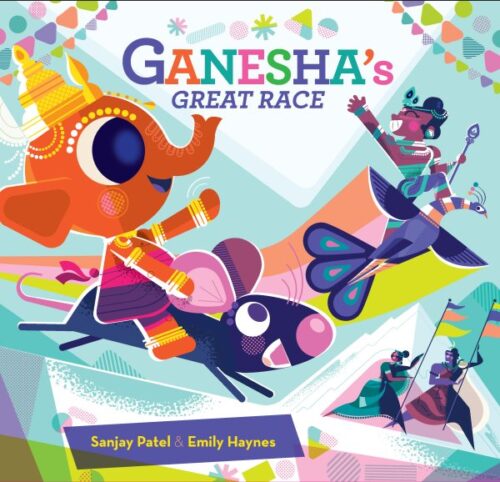
Ganesha and Kartikeya are brothers and best friends but when Kartikeya challenges his elephant-headed bro to a race around the world, how on earth can Ganesha win? A clever update to a classic tale. Some of you may recall that a decade or so ago Patel and Haynes created the picture book Ganesha’s Sweet Tooth. At the time I remember being kind of surprised by the irreverence of the material and not quite sure what to think. Time passed and I came around to the kooky little book. And good thing too! It’s been a long time but finally we’ve a new picture book based on a different tale, and it adapts so smoothly. In the back, Patel and Haynes admit that they’ve changed Ganesha to being a little more uncertain than he was in the initial story, but that’s no crime. Love the art, of course, and maybe it’s my parental vibes talking, but I’m keen on that twist ending.
The Golden Apples by Dan Yashinsky, ill. Ekaterina Khlebnikova
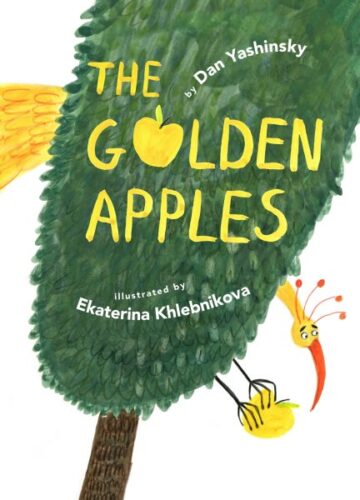
Oh, gutsy! I was surprised at the word count when I picked up this surprisingly hefty fairy tale picture book. Yashinsky isn’t skimping on words, which worried me slightly at first. Then I flipped it open and the very first sentence read, “A long time ago, when the king and queen still loved each other, the queen walked into the garden late one evening.” SOLD! Yashinsky says that this is a story adapted from a wondertale told by Joe Neil MacNeil in Gaelic, translated by John Shaw, and published in the book Tales Until Dawn. But part of what I found so marvelous about it was the sheer weirdness of the story. In this tale a king and queen have three sons. The first two are “impressive-looking lads who got good grades,” while the third, “wasn’t much to look at but the palace cats loved him.” I hope you’re getting a sense of the writing in this, because by the end of that first page I was hooked. The three sons are sent on a quest to retrieve a golden bird that’s been stealing apples from the king’s tree. They are given advice by a fox on their path but the first two ignore it. Don’t get too cocky about the third son, Jack, though, because in true Jack-in-fairytales fashion he listens to some advice and is nice to the fox (good) then proceeds to ignore the fox’s advice from there on in (bad). It all works out in the end (even after the brothers pull a Joseph and the Amazing Technocolor Dreamcoat move on poor Jack) and the art by Khlebnikova is this marvelous mix of old and new together. My favorite part? When the second son, going on the quest, can’t hear the fox’s advice because he’s listening to a podcast called “How to Succeed on Your Quest.” Long and lengthy and you wouldn’t have it any other way.
Olive by Jed Alexander

Forget Jack and the beanstalk. Meet Olive and the beanstalk! A wordless adventure takes Olive to the skies where she discovers that size is relative when you have a friend. Jack and the Beanstalk gets a kick in the pants with this clever retelling of the old fairy tale. The Jack story has been done to death in picture books, actually, but there is something especially fresh and interesting about what Jed Alexander is doing here. I absolutely love how the book is able to wordlessly parallel how Olive feels with the giant, alongside how she feels when she’s a giant to another small creature. It’s about taking responsibility for those smaller than you, and remembering your place. Love the metaphor, love how comfortable the giant is in her own body, and love the wordless storytelling.
One Chicken Nugget by Tadgh Bentley
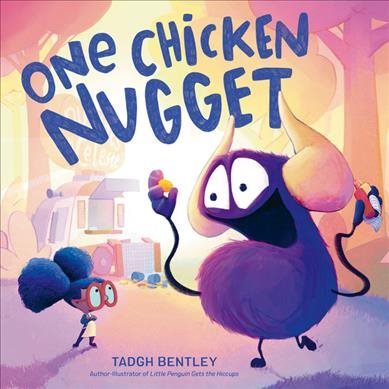
You have to respect any author who looks at Demi’s One Grain of Rice and thinks to themselves, “That’s pretty good, but what if you filled it with chicken nuggets and hungry monsters instead?” Thus is born a legitimately hilarious and downright bizarre math-friendly tale. On the front endpapers (which are filled with fantastic equations) there’s this clever little mention of “The Legend of Sissa ibn Dahir” which is one of the earliest variations of this tale. The story itself is all about exponential growth (as is explained in the magnificently helpful Author’s Note in the back) and gluttony. In it, a monster by the name of Frank has a single scintillating passion: chicken nuggets. Particularly, the nuggets produced by Celeste and her food truck. Trouble is, Celeste is not as enamored of Frank. Monsters aren’t great on the whole payment idea, and Frank has a tendency to eat Celeste’s stock entirely. So she goes to the library, reads up on marketing, math, and folklore (a super combo) and has a Double or Nothing Nugget Eating Challenge (which sounds like a TikTok challenge as well). It’s simple. If for 30 days you can eat double the nuggets you at the day before, and do it for 30 days, you’ll get nuggets for life. This is basically Mr. Beast: The Picture Book. Frank is sure he can handle it, since it seems so simple at the start, but he has no idea how many nuggets are in his future. It’s a hoot, and Bentley’s art perfectly complements the storytelling. Put this one in your yes pile (just be prepared to get hungry for chicken nuggets along the way). Previously Seen On: The Math List
The Rabbi and His Donkey by Susan Tarcov, ill. Diana Renjina
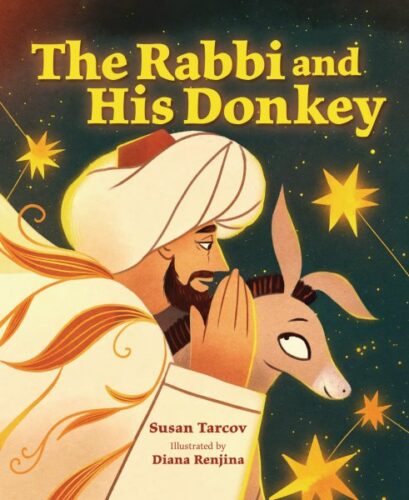
A clever fable about a Rabbit who discovers the answer to an age old question: Is it better to get where you’re going fast or to let your mind travel its own paths at its own rate? Original folktale alert! Okay. Admittedly, though this has all the feels of a folktale, it’s an original tale to its core. I don’t care. I like the historical antecedents to the tale and the ways in which it fits in so nicely with the legend of medieval Sephardic Jewish philosopher Rabbi Moses. The story concerns the Rabbi’s donkey. Every day the rabbi mounts the donkey and goes riding to the sultan’s palace. The donkey is incredibly pleased with this arrangement since the rabbi often speaks his thoughts along the way aloud. One day, however, a beautiful new horse is given to the rabbi so that he won’t delay in coming to the sultan. The donkey is bereft and at first the rabbi agrees to the arrangement. Soon enough, though, he comes to realize that he needs that slow downtime to collect his thoughts every day. I think in our post-lockdown world there’s a lot here we can identify with here. Tarcov’s telling is lovely and the backmatter primo, but it’s Latvian artist Diana Renjina who really brings this beautiful style to each and every last one of the pages. Plus, I like that the horses look similar to the unicorns of Dana Simpson’s Phoebe and Her Unicorn comics.
Schlemiel Comes to America by Jane Yolen, ill. Óscar Perez

Return to the fabled village of Chelm where four classic stories are woven into one utterly ridiculous and hilarious tale. When Schlemiel goes looking for America he may find he didn’t leave all the fools back at home like he thought. I’m a sucker for a good fool’s tale. Pretty much if you’re capable of coming up with some kind of world fool tale, I’m there. Last year my fool tale of choice was The Tale of the Unwelcome Guest by Rebecca Sheir, illustrated by Mert Tugen. This year? Say hello to my friend, Jane Yolen! Jane’s sort of written more children’s books than anyone else living today (this book is #415). No brag. Just fact. So it was with great joy that I encountered her latest. Some of you may be familiar with the stories of the village of Chelm. Chelm has occupied the popular imagination as the home of fools for years. Of this particular book Yolen writes, “There are many stories told about the Chelmites and I have used my own variants of four of them: the Fools in the Angel’s Sack, the Falling Rock, the Bridge, and Digging the Pit.” These four stories are woven together expertly into a tale of the fool Schlemiel (Laverne & Shirley fans, be aware). Over the course of the tale, he determines that it is time to leave home and find America (just not in the Simon & Garfunkle sense). The ease with which Yolen works the U.S. into these old Jewish stories is expert and eerie. All told, if you’re looking for an update on an old form with a bit of Yankee spice, I cannot think of a better book to recommend than this.
The Shade Tree by Suzy Lee, translated by Helen Mixter

Can you buy the shade of a tree? When a rich man runs off anyone enjoying his tree’s shade, it takes the cleverness of a traveler to show just how ridiculous some forms of ownership are. Suzy Lee! I got to see her speak in Bologna for the first time, and I’m such a huge fan of her books. I’ve seen variations on this folktale before (I think Demi did one years ago, maybe?) but I loved Suzy’s take on this. It has this playful, fun point of view that really fits its storyline. Plus, it’s a lesson that isn’t quite as easy to understand as you might think on first glance. This is just such an enjoyable retelling. A great inclusion for this list.
Simon and the Better Bone by Corey R. Tabor

An old Aesop fable gets an upgrade. When Simon the dog spots another pup in a pond with a bone better than his own, his jealousy gets the better of him. I know most folks are probably going to shelve this in the picture book section, but since this is an Aesop fable we’re talking about, I’m putting it in here. Tabor is continuing his vertical streak that started with Mel Fell with an adorable pup. Honestly, this is mighty similar to what Suzy Lee did with Shadow, but that’s not a dig. Like that book, this one completely justifies its orientation. In fact, I’m a little shocked that no one else came up with this idea before Corey did. It doesn’t have the surprise element of Mel Fell, but that’s only because if you know the story already you’ll be in on the joke. Tabor gives it a happier ending than Aesop did, so I suppose we could debate for a while whether or not that completely usurps the message. Regardless, this style is a looser, lovely take. One for the dog lovers.
The Skull: A Tyrolean Folktale by Jon Klassen
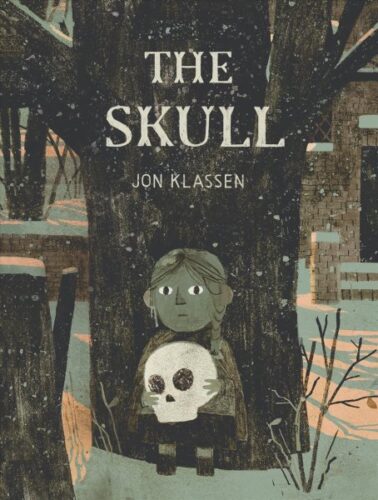
When a runaway girl encounters a lonely skull living in a beautiful home, the two strike up a fast friendship. A clever and touching tale adapted for a modern audience. Maybe it’s the fact that I just finished binging Lockwood & Company on Netflix (which features its own girl/skull relationship) but I’m inordinately fond of this strangely sweet folktale adaptation. 2023 turned out to be a very strong year for folktales and there’s no better example of this than the Author’s Note at the end of this tale. Klassen does a wonderful job of telling the story of how he encountered this folktale in a school library on one of his tours and how the tale haunted him. When he finally had the chance to see it again, he was shocked to discover that the book didn’t end the way he remembered. But isn’t that true of all folktales? We hear them and then our brains remember them in different ways. Klassen’s version is remarkable, and since this is following up his work on Mac Barnett’s Three Billy Goats Gruff from last year, I declare him our new master of folks and fairy tales. When you read this book (which has a particularly clever heroine) I think you’ll agree.
The Song That Called Them Home by David A. Robertson, ill. Maya McKibbin
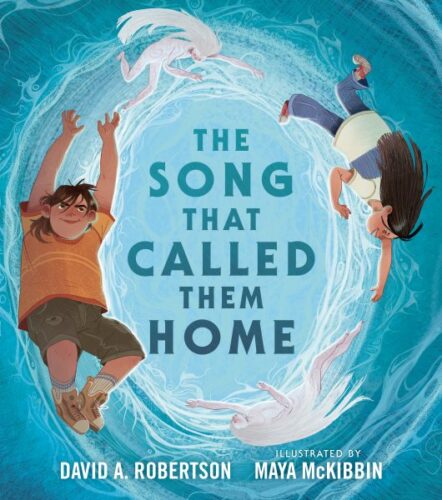
ADVERTISEMENT
ADVERTISEMENT
Inspired by the stories of the Indigenous communities of Turtle Island, two siblings are lured by the inescapable song of the Memekwesewak until the person who loves them best can call them home again. Well, I am impressed. You’ve got two contemporary kids in this book, written by a member of the Norway House Cree Nation and illustrated by a Two-Spirited Ojibwe, Yoeme, and Irish-settler artist. I love that it takes a range of stories and makes something both new and old out of it. The illustrations are absolutely delightful (there’s something deeply unsettling about the Memekwesewak pictured here). As with many of these books, I would have loved to have seen some sources or a short bibliography at the end, but as it stands I think it’s rather strong.
Stories of the Islands by Clar Angkasa

Three classic Indonesian folktales are reinterpreted through a feminist lens into beautifully rendered comics. From “Keong Mas” and “Bawang Merah Bawang Putih” to “Timun Mas”, old stories are given new life. Angkasa does a neat thing with this book where she presents each of the stories as a comic, then at the end tells the original folktale. In two cases there are some key differences, but honestly I didn’t think she took many liberties at all with the third tale. That one (Timun Mas) was always a strong mother/daughter story anyway. Angkasa has chosen some great tales, and I think her storytelling instincts and illustration style are highly appealing. Even kids that would normally eschew fairy and folktales are going to enjoy this. If I’m going to nitpick, I would have love to have seen a Bibliography of recommended Indonesian folktales at the back of the book, but beyond that I’ve no notes.
Who Will Win? by Arihhonni David

When Bear and Turtle are set to race, will brains win over brawn? A delightful retelling of a traditional Haudenosaunee tale, told in easy to read language for beginning readers. Oh, this works quite well! A traditional Haudenosaunee tale is adapted into Holiday House’s “I Like to Read” series, so honestly this would fit in just as well in the Easy Books category as this Folktale one. I’d heard the tale before but I still found myself surprised by the twist. The art is cartoonish but I really enjoyed it and thought that it served the story well.
Zhen Yu and the Snake by Erica Lyons, ill. Renia Metallinou
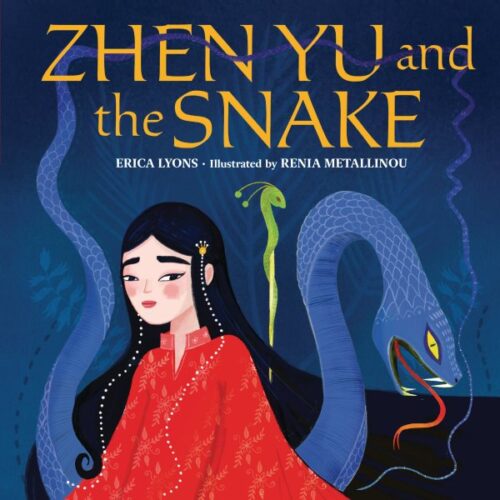
Tales from China are no stranger to this annual list, but this is the first book that I’ve seen to base its tale within the Kaifeng Jewish community. Lyons has based the story on the Talmudic tale of Rabbi Akiva’s daughter and the snake (Shabbat, 156b) but tweaks it slightly to change both its location and the precise reason for the happy ending. In this tale a man prophesizes to a father that on her wedding night his daughter will be bitten by a poisonous snake. Years later the girl has grown up and it’s the day of her wedding. A poor stranger comes to the door and she places her hair pin in the wall and offers him many of her wedding gifts. When she pulls out the pin, it has killed a snake. Now where this differs from the original is that in the Lyons version, the act of helping someone and putting the pin in the wall are connected. I enjoyed the straightforward telling of the tale, and the tones and hues of the art as well. Backmatter includes additional information about the Kaifeng Jewish community. A smart update of an old tale.
Hope you enjoyed these! Here are the lists you can expect for the rest of this month:
December 1 – Great Board Books
December 2 – Picture Book Readaloud
December 3 – Simple Picture Book Texts
December 4 – Transcendent Holiday Picture Books
December 5 – Rhyming Picture Books
December 6 – Funny Picture Books
December 7 – CaldeNotts
December 8 – Picture Book Reprints
December 9 – Math Books for Kids
December 10 – Gross Books
December 11 – Books with a Message
December 12 – Fabulous Photography
December 13 – Translated Picture Books
December 14 – Fairy Tales / Folktales / Religious Tales
December 15 – Wordless Picture Books
December 16 – Poetry Books
December 17 – Unconventional Children’s Books
December 18 – Easy Books & Early Chapter Books
December 19 – Older Funny Books
December 20 – Science Fiction Books
December 21 – Fantasy Books
December 22 – Comics & Graphic Novels
December 23 – Informational Fiction
December 24 – American History
December 25 – Science & Nature Books
December 26 – Unique Biographies
December 27 – Nonfiction Picture Books
December 28 – Nonfiction Books for Older Readers
December 29 – Audiobooks for Kids
December 30 – Middle Grade Novels
December 31 – Picture Books
Filed under: 31 Days 31 Lists, Best Books, Best Books of 2023
About Betsy Bird
Betsy Bird is currently the Collection Development Manager of the Evanston Public Library system and a former Materials Specialist for New York Public Library. She has served on Newbery, written for Horn Book, and has done other lovely little things that she'd love to tell you about but that she's sure you'd find more interesting to hear of in person. Her opinions are her own and do not reflect those of EPL, SLJ, or any of the other acronyms you might be able to name. Follow her on Twitter: @fuseeight.
ADVERTISEMENT
ADVERTISEMENT
SLJ Blog Network
Name That LEGO Book Cover! (#53)
Exclusive: Vol. 2 of The Weirn Books Is Coming in October | News
Fighting Public School Book Bans with the Civil Rights Act
North Texas Teen Book Festival 2024 Recap
ADVERTISEMENT








So much overlap with my list for Tablet. We both must have excellent taste!
Indeed!!
Any thoughts from you or other readers about middle grade (or YA) fairy tale and folk tale retellings?
You may see a crop of them come up with the fantasy list I produce later this month.
I find it sad that many children today are not exposed to traditional folk tales, nursery rhymes, fairy tales and traditional Old Testament stories. That knowledge base is often why I enjoy the creativity of the spin-offs.